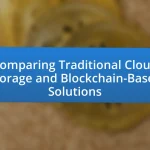Blockchain is a decentralized digital ledger technology that enhances file sharing in cloud environments by improving security, transparency, and efficiency. This technology allows for peer-to-peer file transfers without a central authority, reducing the risk of data breaches and unauthorized access. Key components of blockchain, such as decentralization, immutability, and smart contracts, contribute to its effectiveness in addressing traditional file sharing challenges, including security vulnerabilities and inefficiencies. The article explores how blockchain can transform file sharing across various industries, the practical applications of this technology, and the potential drawbacks and best practices for implementation.

What is Blockchain and How Does it Relate to File Sharing in Cloud Environments?
Blockchain is a decentralized digital ledger technology that securely records transactions across multiple computers, ensuring that the data cannot be altered retroactively without the consensus of the network. In the context of file sharing in cloud environments, blockchain enhances security, transparency, and efficiency by enabling peer-to-peer sharing without the need for a central authority. This eliminates single points of failure and reduces the risk of data breaches, as files can be encrypted and stored across a distributed network. Additionally, blockchain’s smart contracts automate and enforce agreements related to file access and usage, streamlining processes and reducing administrative overhead.
How does blockchain technology function in general?
Blockchain technology functions as a decentralized digital ledger that records transactions across multiple computers in a way that ensures the recorded data cannot be altered retroactively. Each transaction is grouped into a block, which is then linked to the previous block, forming a chain. This structure is secured through cryptographic hashing, which provides integrity and authenticity to the data. The decentralized nature of blockchain means that no single entity has control over the entire chain, reducing the risk of fraud and increasing transparency. According to a report by the World Economic Forum, blockchain can enhance data security and trust in various applications, including file sharing in cloud environments, by allowing users to verify transactions without relying on a central authority.
What are the key components of blockchain technology?
The key components of blockchain technology are decentralization, transparency, immutability, consensus mechanisms, and smart contracts. Decentralization ensures that no single entity controls the entire network, enhancing security and reducing the risk of failure. Transparency allows all participants to view transaction records, fostering trust among users. Immutability guarantees that once data is recorded on the blockchain, it cannot be altered or deleted, which is crucial for maintaining integrity. Consensus mechanisms, such as Proof of Work or Proof of Stake, enable participants to agree on the validity of transactions, ensuring that all copies of the blockchain are synchronized. Smart contracts are self-executing contracts with the terms directly written into code, automating processes and reducing the need for intermediaries. These components collectively contribute to the robustness and reliability of blockchain technology, making it suitable for applications like file sharing in cloud environments.
How does decentralization enhance security in file sharing?
Decentralization enhances security in file sharing by distributing data across multiple nodes, reducing the risk of a single point of failure. In a decentralized system, each participant holds a copy of the data, making it significantly harder for malicious actors to compromise the entire network. For instance, blockchain technology employs cryptographic techniques to secure data transactions, ensuring that any alteration is easily detectable. This distributed ledger system not only protects against unauthorized access but also enhances data integrity, as changes require consensus from multiple nodes, thereby increasing overall security.
What challenges exist in traditional file sharing methods?
Traditional file sharing methods face several challenges, including security vulnerabilities, lack of control over data, and inefficiencies in collaboration. Security vulnerabilities arise from the risk of unauthorized access and data breaches, as traditional methods often rely on centralized servers that can be targeted by cyberattacks. The lack of control over data is evident when users cannot track who accesses their files or how they are used, leading to potential misuse. Additionally, inefficiencies in collaboration occur due to the limitations of version control and the difficulty in managing multiple file versions, which can result in confusion and errors among users. These challenges highlight the need for more secure and efficient solutions, such as blockchain technology, which can address these issues by providing decentralized, transparent, and tamper-proof file sharing capabilities.
How do security vulnerabilities affect file sharing?
Security vulnerabilities significantly compromise file sharing by exposing sensitive data to unauthorized access and potential breaches. For instance, vulnerabilities in file-sharing protocols can allow attackers to intercept and manipulate files during transmission, leading to data leaks or corruption. According to a report by the Ponemon Institute, 60% of organizations experienced a data breach due to vulnerabilities in file-sharing systems, highlighting the critical need for secure protocols. Additionally, malware can exploit these vulnerabilities, further endangering the integrity of shared files. Thus, addressing security vulnerabilities is essential to ensure safe and reliable file sharing in cloud environments.
What are the limitations of current cloud storage solutions?
Current cloud storage solutions face several limitations, including security vulnerabilities, data privacy concerns, and dependency on internet connectivity. Security vulnerabilities arise from potential data breaches, as evidenced by incidents like the 2019 Capital One breach, which exposed over 100 million customer records. Data privacy concerns stem from the centralized nature of cloud services, where user data is often stored on third-party servers, leading to risks of unauthorized access. Additionally, reliance on internet connectivity can hinder access to data during outages or slow connections, impacting user experience and productivity. These limitations highlight the need for more secure and decentralized alternatives, such as blockchain technology, to enhance file sharing in cloud environments.

How Can Blockchain Improve File Sharing in Cloud Environments?
Blockchain can improve file sharing in cloud environments by enhancing security, transparency, and efficiency. The decentralized nature of blockchain allows for secure peer-to-peer file transfers without the need for intermediaries, reducing the risk of data breaches. Additionally, blockchain’s immutable ledger ensures that all transactions are recorded transparently, providing a clear audit trail for file access and modifications. This transparency can help in verifying the authenticity of files and tracking their usage. Furthermore, smart contracts can automate file sharing agreements, streamlining the process and reducing administrative overhead. These features collectively contribute to a more secure and efficient file sharing ecosystem in cloud environments.
What specific advantages does blockchain offer for file sharing?
Blockchain offers enhanced security, transparency, and decentralization for file sharing. The decentralized nature of blockchain eliminates single points of failure, reducing the risk of data breaches and unauthorized access. Each file shared on a blockchain is encrypted and linked to a unique cryptographic hash, ensuring that any alteration is easily detectable. Furthermore, blockchain provides a transparent audit trail, allowing users to verify the authenticity and ownership of files without relying on a central authority. This combination of security features and transparency significantly improves trust among users in cloud environments.
How does blockchain enhance data integrity and authenticity?
Blockchain enhances data integrity and authenticity by providing a decentralized and immutable ledger that records transactions in a secure manner. Each transaction is cryptographically linked to the previous one, creating a chain that is resistant to tampering. This structure ensures that once data is recorded, it cannot be altered without consensus from the network, thereby maintaining its integrity. Additionally, the use of cryptographic hashes and digital signatures verifies the authenticity of the data, ensuring that it originates from a legitimate source. For example, in a study by Nakamoto in 2008, the foundational principles of blockchain were established, demonstrating how these mechanisms prevent unauthorized changes and ensure trust in digital transactions.
What role does smart contract technology play in file sharing?
Smart contract technology facilitates automated and secure transactions in file sharing by enabling predefined conditions to be executed without intermediaries. This technology ensures that files are shared only when specific criteria are met, such as payment confirmation or user authentication, thereby enhancing security and trust among users. For instance, in decentralized file-sharing platforms, smart contracts can automatically manage access rights and royalties, ensuring that creators receive compensation when their files are accessed or downloaded. This automation reduces the risk of fraud and disputes, as all transactions are recorded on the blockchain, providing a transparent and immutable ledger of activities.
How does blockchain address security concerns in file sharing?
Blockchain addresses security concerns in file sharing by providing a decentralized and immutable ledger that enhances data integrity and access control. This technology ensures that files are encrypted and stored across a distributed network, making unauthorized access and tampering significantly more difficult. Each transaction or file-sharing event is recorded in a block, which is linked to previous blocks, creating a chain that is resistant to alteration. For instance, a study by the University of Cambridge highlights that blockchain’s cryptographic techniques protect data from breaches, as only authorized users with the correct cryptographic keys can access or modify the files. This decentralized approach not only mitigates the risks associated with single points of failure but also enhances transparency and accountability in file sharing processes.
What mechanisms does blockchain use to prevent unauthorized access?
Blockchain employs cryptographic techniques, consensus mechanisms, and decentralized architecture to prevent unauthorized access. Cryptography secures data through hashing and encryption, ensuring that only authorized users can access or modify information. Consensus mechanisms, such as Proof of Work or Proof of Stake, validate transactions and maintain the integrity of the blockchain, making it difficult for unauthorized entities to alter records. Additionally, the decentralized nature of blockchain distributes data across multiple nodes, reducing the risk of a single point of failure or attack, thereby enhancing security against unauthorized access.
How does encryption work within blockchain for file sharing?
Encryption within blockchain for file sharing secures data by converting it into a format that is unreadable without a decryption key. This process involves cryptographic algorithms, such as AES (Advanced Encryption Standard) or RSA (Rivest-Shamir-Adleman), which ensure that only authorized users can access the original files. Each file shared on the blockchain is hashed, creating a unique digital fingerprint that is stored on the blockchain, ensuring integrity and authenticity. Additionally, the decentralized nature of blockchain means that no single entity controls the data, further enhancing security. This method of encryption not only protects sensitive information during transmission but also ensures that any alterations to the file can be detected, as the hash will change if the file is tampered with.

What are the Practical Applications of Blockchain in Cloud File Sharing?
Blockchain technology enhances cloud file sharing through decentralized storage, improved security, and enhanced data integrity. By utilizing blockchain, files can be stored across a distributed network, reducing reliance on a single point of failure and increasing availability. Security is bolstered as blockchain employs cryptographic techniques to ensure that only authorized users can access or modify files, thereby minimizing the risk of data breaches. Additionally, the immutable nature of blockchain records ensures that any changes to files are transparently logged, providing a reliable audit trail that enhances trust among users. These applications are supported by various implementations, such as Filecoin and Storj, which leverage blockchain to create decentralized file storage solutions.
Which industries are adopting blockchain for file sharing?
The industries adopting blockchain for file sharing include finance, healthcare, supply chain management, and media. In finance, blockchain enhances security and transparency in transactions, while in healthcare, it enables secure sharing of patient records. Supply chain management benefits from blockchain by providing traceability and authenticity of products, and the media industry utilizes it for copyright protection and distribution of digital content. These sectors leverage blockchain technology to improve data integrity, reduce fraud, and streamline operations.
How is blockchain being used in healthcare for file sharing?
Blockchain is being used in healthcare for file sharing by providing a secure, decentralized platform that enhances data integrity and patient privacy. This technology allows healthcare providers to share patient records and medical data in a tamper-proof manner, ensuring that only authorized parties can access sensitive information. For instance, a study published in the Journal of Medical Internet Research highlights that blockchain can facilitate interoperability among different healthcare systems, enabling seamless data exchange while maintaining compliance with regulations like HIPAA. By utilizing cryptographic techniques, blockchain ensures that any alterations to the data are easily traceable, thereby increasing trust among stakeholders in the healthcare ecosystem.
What examples exist of blockchain in the finance sector for file sharing?
Examples of blockchain in the finance sector for file sharing include Ripple and IBM’s Food Trust. Ripple utilizes blockchain technology to facilitate secure and efficient cross-border payments, allowing financial institutions to share transaction data in real-time while maintaining transparency and security. IBM’s Food Trust leverages blockchain to enhance supply chain transparency, enabling financial entities to share critical data related to food safety and provenance, thus improving trust and accountability in transactions. Both examples demonstrate how blockchain can streamline file sharing processes in finance by ensuring data integrity and reducing the risk of fraud.
What are the potential drawbacks of using blockchain for file sharing?
The potential drawbacks of using blockchain for file sharing include scalability issues, high energy consumption, and regulatory challenges. Scalability is a significant concern as blockchain networks can become congested, leading to slower transaction times and increased costs; for instance, Bitcoin’s network can handle only about 7 transactions per second compared to traditional systems like Visa, which can process thousands. High energy consumption is another drawback, as the proof-of-work consensus mechanism used by many blockchains requires substantial computational power, contributing to environmental concerns. Additionally, regulatory challenges arise due to the decentralized nature of blockchain, which can complicate compliance with data protection laws such as GDPR, potentially exposing users to legal risks.
How does scalability impact blockchain file sharing solutions?
Scalability significantly impacts blockchain file sharing solutions by determining the system’s ability to handle increased data loads and user demands without compromising performance. As the number of users and files grows, a scalable blockchain solution can maintain fast transaction speeds and low latency, essential for efficient file sharing. For instance, Ethereum’s transition to a proof-of-stake consensus mechanism aims to enhance scalability, allowing for thousands of transactions per second, which is crucial for widespread adoption in file sharing applications. In contrast, a non-scalable blockchain may experience congestion, leading to slower transactions and higher costs, ultimately hindering user experience and limiting the technology’s effectiveness in cloud environments.
What are the regulatory challenges associated with blockchain file sharing?
Regulatory challenges associated with blockchain file sharing include compliance with data protection laws, intellectual property rights, and jurisdictional issues. Data protection laws, such as the General Data Protection Regulation (GDPR) in Europe, impose strict requirements on how personal data is stored and processed, which can conflict with the immutable nature of blockchain technology. Intellectual property rights present challenges as blockchain file sharing can facilitate unauthorized distribution of copyrighted materials, complicating enforcement. Additionally, jurisdictional issues arise because blockchain operates across borders, making it difficult to determine which laws apply and how to enforce them effectively. These challenges necessitate careful consideration and adaptation of existing regulatory frameworks to accommodate the unique characteristics of blockchain technology.
What best practices should be followed when implementing blockchain for file sharing?
When implementing blockchain for file sharing, best practices include ensuring data integrity through cryptographic hashing, utilizing smart contracts for automated transactions, and maintaining user privacy with encryption techniques. Data integrity is achieved by creating unique hashes for files, which allows users to verify that files have not been altered. Smart contracts facilitate secure and automatic execution of agreements, reducing the need for intermediaries and enhancing efficiency. Additionally, employing encryption protects sensitive information during transmission and storage, ensuring that only authorized users can access the files. These practices are supported by the inherent features of blockchain technology, which provides a decentralized and tamper-proof environment for file sharing.
How can organizations ensure compliance with data protection regulations?
Organizations can ensure compliance with data protection regulations by implementing robust data governance frameworks that include regular audits, employee training, and the use of encryption technologies. These frameworks help organizations identify and mitigate risks associated with data handling, ensuring adherence to regulations such as the General Data Protection Regulation (GDPR) and the Health Insurance Portability and Accountability Act (HIPAA). For instance, a study by the International Association of Privacy Professionals (IAPP) found that organizations with comprehensive data protection strategies are 50% less likely to experience data breaches, demonstrating the effectiveness of proactive compliance measures.
What strategies can enhance user adoption of blockchain file sharing solutions?
To enhance user adoption of blockchain file sharing solutions, implementing user-friendly interfaces and providing comprehensive educational resources are essential strategies. User-friendly interfaces simplify the interaction with blockchain technology, making it accessible to non-technical users. For instance, platforms like Filecoin and Storj have successfully integrated intuitive designs that facilitate ease of use. Comprehensive educational resources, including tutorials and webinars, help users understand the benefits and functionalities of blockchain file sharing, addressing concerns about security and usability. Research indicates that 70% of users are more likely to adopt new technology when they receive adequate training and support, highlighting the importance of these strategies in driving user adoption.


